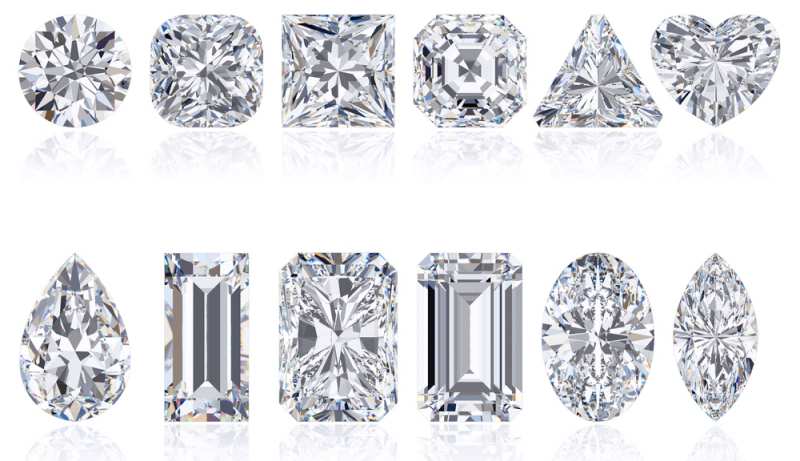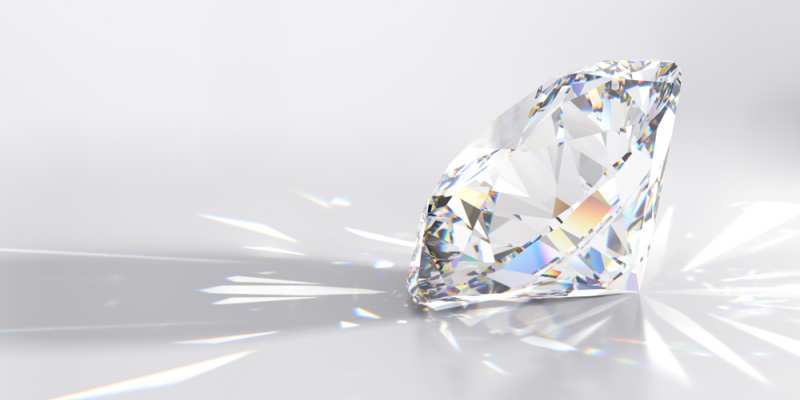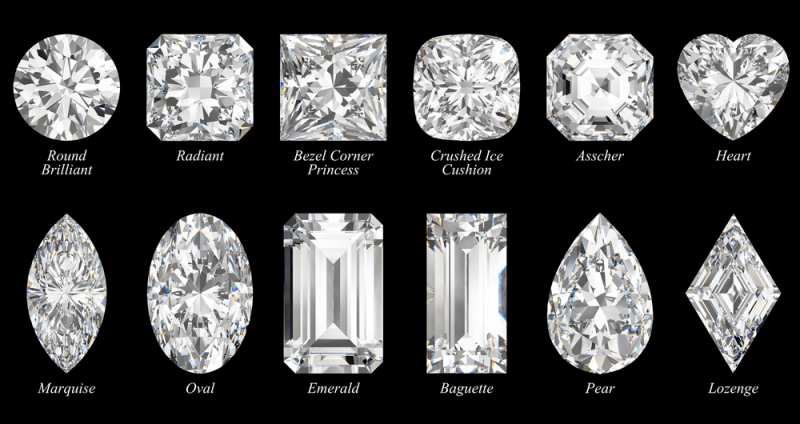Diamonds exhibit a wide range of shapes, from the classic round cut to more intricate designs like heart and pear shapes. Each diamond shape possesses its own unique advantages and disadvantages, including factors such as brilliance, appearance, and price per carat.
With such diversity, it’s natural to wonder: Which diamond shape reigns supreme? In truth, there is no definitive answer to this question as the “best” diamond shape is subjective and dependent on your personal preferences and budget. However, equipping yourself with basic knowledge about these diamond shapes can assist you in selecting the ideal diamond for your needs.
In this article, we explore some of the most popular diamond shapes, aiming to provide guidance in your quest for the perfect diamond. So, let’s not waste any more time and delve into the fascinating world of diamond shapes.
DESIGN YOUR OWN ENGAGEMENT RING: START WITH A SETTING OR START WITH A DIAMOND. IT’S REALLY UP TO YOU!

The Most Popular Diamond Shapes
In this section, we have explored some of the most popular and highly sought-after diamond shapes. Let’s take a closer look at each one:
- Round Brilliant Cut Diamonds:
The round brilliant cut is the most popular diamond shape, accounting for approximately two-thirds of all diamond sales. Its fame dates back to Marcel Tolkowsky’s study in 1919, which determined the ideal angles for maximum brilliance and fire. With 58 facets, including the culet, round brilliant diamonds offer exceptional light reflection. It is crucial to assess the cut quality and review GIA reports when purchasing a round brilliant diamond. - Princess Cut Diamonds:
As the second most popular diamond shape, the princess cut is created from an inverted pyramid of the rough stone. It offers impressive brilliance and fire, comparable to round brilliant diamonds, while maintaining a square outline. When buying a princess cut diamond, it is advisable to use prong settings on all corners to protect them. Inclusions near the edges can be concealed by the prongs. The price per carat for princess cut diamonds is typically lower than round brilliant cut diamonds due to higher yield during cutting. - Emerald Cut Diamonds:
The emerald cut derives its name from the cutting method initially used for emeralds. It showcases straight and long lines, known as steps, and a large table surface, resulting in abundant reflections. Emerald cut diamonds are available in both rectangle and square shapes. Due to their large table, inclusions may be more visible in these diamonds. It is recommended to look for VS1 or VS2 clarity grades for this diamond shape. Emerald cut diamonds offer excellent size perception and are a popular choice for those seeking a larger stone. - Cushion Cut Diamonds:
Combining a square shape with rounded edges, the cushion cut diamond exhibits brilliance and fire due to its precise light dispersion. Cushion cut diamonds can be designed in various variants, including standard, modern, and modified cuts. Optimal brilliance is maintained when the table size is below 70% and the depth is also below 70%. Cushion cut diamonds allow for personalization and creativity, embodying a blend of classic fashion and modern sparkle. - Asscher Cut Diamonds:
The Asscher cut, invented by the Asscher Brothers in 1902, offers an alternative to the emerald cut. It features a smaller table and more layered facets, resulting in brilliance achieved through light reflection between the square facets. Asscher cut diamonds have trimmed corners, adding stability and style. They do not conceal the color of the rough material as effectively as other popular cuts, so a minimum H color grade is recommended. Asscher cut diamonds exhibit a stunning appeal due to their deep pavilion, precision, and 58 facets. - Pear Shaped Diamond:
The pear-shaped diamond is an elegant and timeless choice, with a rounded side tapering to a distinct point. Symmetry is crucial for a balanced appearance and even shimmer. All pear-shaped diamonds typically exhibit a bowtie, a dark zone across the center, but the severity of the bowtie should be considered. Pear-shaped diamonds make stunning engagement rings and are a unique alternative to more traditional cuts like the round brilliant. They also conceal inclusions well. - Oval Diamonds:
The oval diamond offers similar brilliance to the round brilliant cut while presenting a distinctive elongated silhouette. Care should be taken to assess the severity of the bowtie in oval diamonds. The absence of pointed edges enhances the durability of oval diamonds, and they often come at a lower price point than round brilliants. - Heart Shaped Diamond:
Symbolizing love, the heart-shaped diamond is a recognizable choice for engagement rings. The diamond’s width and slenderness can vary based on personal preference, but it should display symmetrical proportions and a distinct point. Heart-shaped diamonds are often set in higher carat weights, and a three-prong setting can accentuate the heart’s outline. Due to its unique form, the heart-shaped diamond typically requires the highest cut grade, potentially increasing its value over time.
Each diamond shape has its own charm and characteristics, so consider your preferences and requirements when selecting the perfect diamond for yourself.

Which Diamond Shape Sparkles The Most?
The round brilliant cut diamond is renowned for its exceptional brilliance, thanks to its perfectly optimized 58 facets. However, other diamond shapes can also display high levels of sparkle, including the radiant cut, cushion cut, and oval cut.
While the shape of the diamond influences its brilliance, it is not the sole factor determining its sparkle. The quality of the cut plays a significant role in how much a diamond sparkles. Even a round brilliant cut diamond can have reduced sparkle if it has a poor cut grade. Therefore, it is essential to consider more than just the shape when seeking a diamond with excellent brilliance and fire.
Regarding cost, the round brilliant cut is typically the most expensive diamond cut. Due to the significant amount of rough diamond lost during the cutting process (around 40% for a round brilliant cut), the same quality, clarity, color, and carat weight diamond in a different shape would be priced lower. Diamond shapes like the Asscher cut, emerald cut, radiant cut, cushion cut, and princess cut tend to be more affordable as they utilize a larger portion of the rough diamond.
However, each diamond characteristic can impact its price and overall value. For example, while an emerald cut may be less expensive than a round brilliant cut, its larger table makes it more likely to reveal color or inclusions. Consequently, opting for a higher clarity and color grade may be necessary, reducing some of the cost advantage.
In terms of appearance, diamond cuts with elongated shapes often appear larger compared to round or square shapes. This is because the elongated shapes tend to have a larger surface area relative to their carat weight. Diamond shapes that create an impression of a larger size include the pear cut, oval cut, and emerald cut. Conversely, princess cut, Asscher cut, and cushion cut diamonds can appear smaller due to their square length-to-width ratio, resulting in a smaller surface area and diameter relative to their carat weight.

Conclusion
Determining the “best” diamond shape is subjective and depends on individual preferences. Each shape has its own advantages and disadvantages, so the best shape for you will depend on your personal taste and budget.
The round brilliant cut diamond is known for its exceptional brilliance, making it a popular choice. However, it is also typically the most expensive in terms of cost per carat.
If you are seeking a balance between brilliance and value, pear and oval diamonds often give the impression of a larger size compared to their actual carat weight. This can provide a good combination of sparkle and affordability.
Ultimately, the best diamond shape is the one that you and your future fiancé find most appealing and valuable. It’s important to choose a shape that resonates with your personal preferences and brings joy and satisfaction.


